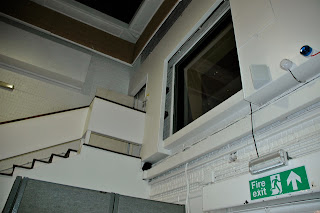I love John's Roller. The 1965 Phantom V (FJB 111C) was delivered to John in gleaming black, and he had the hubcaps sprayed black to match. Judging from these pictures of the Beatles travelling to the palace in the car to collect their MBEs, it seems that he also had the bumpers sprayed black too:
But the bumpers were back to the original chrome finish by 1966 when John used his car in Spain whilst filming How I Won The War:
The car was painted around about May 1967 by JP Fallon coachbuilders in Chertsey, Surrey. They commissioned an artist called Steve Weaver to design the artwork for them and then painted this design onto the car. It's often been reported that The Fool painted the car but this isn't the case, although one of its members, Marijke Koger, claimed that she suggested the idea to John in the first place. Here's the car being delivered to John after JP Fallon had finished with it:
He had some cool gadgets fitted to the car, including a record player. I mean, how does a record player work in a car? Surely the stylus would bounce all over the place, even in a car as refined and smooth as the Rolls? That's where the Philips Auto-Mignon AG2101 comes in. It was specifically designed for in car use and had a clever suspension-type mechanism in it which prevented the record from jumping. You'd slot your single into the record player like you do in a car CD player nowadays and away it played.
Here's John sitting in the back of the car in Spain in 1966:
And here are some close ups of the Auto-Mignon in that audio-visual centre console of his:
Can you spot the Sgt Pepper relic in the pics above? John's portable Sony TV (Sony 9-306UB Transistor TV Receiver) was the same model as the one used on the Sgt Pepper cover.
Who knows, maybe the TV on the cover was John's telly out of the Phantom?
Another groovy little toy that John had installed in the car was a loudspeaker system. This allowed John to have some japes speaking to people outside from within. Here's Paul telling a little story about one such jape involving Brian Jones:
"...we would play jokes on him. I remember being in Hyde Park, coming back from John's house in his big chauffeur-driven Rolls-Royce. John had a microphone he could use with the speakers mounted underneath the car. We were driving through the park, and ahead of us was Brian's Austin Princess. Everyone used to go around in these big Austin Princesses then, it was a sign you were a pop star. You automatically got one of those. We could see his big floppy hat and blond hair and we could see him nervously smoking a ciggie in the back of the car. So John got on the mike and said, 'Pull over now! Brian Jones! You are under arrest! Pull over now!' Brian jumped up. 'Fucking hell!' He really thought he had been busted. He was shitting himself! Then he saw it was us. And we were going, 'Yi, yi, yi. Fuck off!' giving V-signs out of the car window."
Here are the mic controls, below the Auto-Mignon in the Roller's centre console. You can see the 'Mic. Press To Talk' button right at the bottom:
The speakers themselves were fitted into the front wheelarches of the car:
A telephone and foldaway bed were 2 more of the luxuries that John had fitted to the car. He eventually tired of the Rolls, as from sometime in 1968 onwards, he took to using his white Phantom V instead. Maybe it became a bit too 1967 and psychedelic for him, as he moved to his more minimal look.
After John gave it away as part of a US tax deal in the late 70s, the car had a bit of a convoluted journey (including being sold by Sothebys for $2.2 million in 1985) and is now owned by and resides at the Royal British Colombia Museum in Victoria, British Colombia.

















































